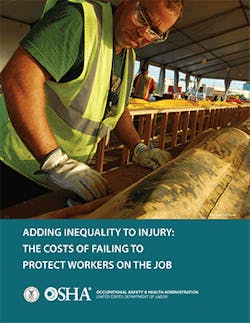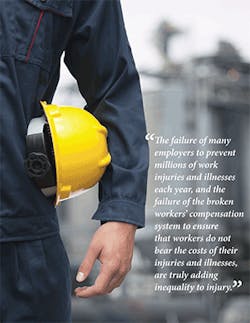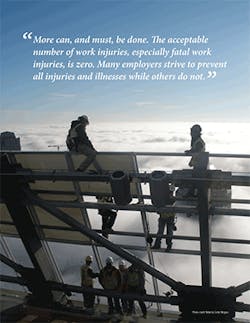Each year, the Bureau of Labor Statistics (BLS) releases data regarding workplace injuries, illnesses and fatalities. The data is sliced and diced according to industry, job task, body part, causation and demographics (age, sex, race). This enormous amount of data usually adds up to slightly fewer fatalities and injuries than the year before and points to some industries and demographics where more education is needed.
For Guadalupe Gonzalez, a permanently, catastrophically injured ankle should have caused enough suffering for a lifetime, but her pain did not end there. When she found out that her on-the-job injury would cost her all future job prospects and a 40 percent reduction in her already low-wages, suffering turned to despair.
She is not alone. She is one of 3 million workers seriously injured at work every year.
The report from OSHA notes that on average, a worker who is seriously injured will earn 15 percent less over a 10-year period and will bear 50 percent of the costs associated with that injury. For workers like Guadalupe, that means the American dream becomes a nightmare.
“The costs of workplace injuries are borne primarily by injured workers, their families, and taxpayer-supported components of the social safety net,” writes Dr. David Michaels, assistant secretary of Labor for Occupational Safety and Health. “These injuries and illnesses add to the pressing issue of income inequality because they force working families out of the middle class and into poverty, and keep the families of lower-wage workers from ever getting out.”
Millions Injured, Sickened Each Year
BLS estimates that employers record nearly 3 million serious occupational injuries and illnesses annually on legally mandated logs. Recordable workplace injuries and illnesses range in severity from wounds, amputations, back injuries and other serious condition requiring care beyond first aid (injuries receiving only first aid are not recordable) to fatal injuries. Approximately half of recorded injuries require at least a day away from work, a job transfer or a work restriction for recovery.
The report notes that while the estimate of 3 million serious work-related injuries each year may seem extremely high, “it is undoubtedly only a fraction of the true number.”
Numerous studies provide documentation that many – and perhaps the majority – of work-related injuries are not recorded by employers, and that the actual number of workers injured each year is likely to be far higher than the BLS estimate. Additionally, many workplace illnesses do not become symptomatic until long after the exposure and are not traced back to their work-related cause.
Cost of Workplace Injuries, Illnesses in Billions
As noted in the report (and in other articles on EHSToday.com), the economic costs of these occupational injuries and illnesses are enormous. The National Safety Council, for example, estimates the cost of fatal and non-fatal work injuries at $198 billion in 2012. Compare this cost to the estimated costs of dementia (Rand Corporation estimates the annual costs of dementia, including Alzheimer’s, in 2010 was between $159 billion and $215 billion) and of diabetes (2012 costs were estimated by the American Diabetes Association at $245 billion).
While workers’ compensation programs were created to cover the cost of medical treatment of work-related injuries and illnesses and provide injured and ill workers with short-term and long-term disability payments to help ease the financial burden, workers – and their families – suffer significant financial loss.
The report notes, “A recent study found that workers in New Mexico who receive workers’ compensation benefits for wage loss caused by workplace injuries lose an average of 15 percent of the earnings they would have been expected to earn over the 10 years following the injury. Even with workers’ compensation benefits, injured workers’ incomes are, on average, almost $31,000 lower over 10 years than if they had not been injured. This figure does not reflect the even more substantial losses suffered by the many injured workers who never enter the workers’ compensation system.”
And the hard costs don’t reflect the emotional toll an injury or illness takes on the employee or his or her family members. A father who is unable to play with his children, a mother who spends every day in bed because she is unable to breathe, older parents who bear the burden of caring for a child who was disabled in a work injury… These are the highest costs of unsafe workplaces related to workplace injuries and illnesses.
Trends in Market Impact Worker Safety and Health
Several trends in the labor market have created greater challenges to worker safety and health. These trends include the increased presence of employees of multiple employers at the same worksite, the pervasive misclassification of wage employees as independent contractors and the widespread use of temporary employees provided by labor staffing agencies.
If several firms employ workers at the same site, and employers do not actively collaborate to ensure safe workplaces, all workers at the site may be a higher risk of injury. Although this pattern of employment has been true in the construction industry for many years, it now has become more common in other sectors of the economy. More and more, workers are not actual employees of the employer who owns or controls the workplace where they work. Instead, they may be employed by a contractor or subcontractor, or by a staffing agency.
According to OSHA, this trend has a significant, negative impact on the safety and health of U.S. workers To address this, the agency often cites employers for endangering the employees of other employers working at the same jobsite.
Misclassification of employees as independent contractors also increases the risks for these workers. In the construction industry, the proportion of the workforce misclassified as independent contractors is substantial, according to OSHA, although documenting it is difficult because the employers are breaking the law and don’t want to incriminate themselves.
The report cites research from the McClatchy newspaper chain, which recently studied this topic and estimated that in Texas, 37.7 percent of all construction workers were misclassified as independent contractors. They reported smaller but still substantial proportions of misclassified construction workers in North Carolina (35.2 percent) and Florida (15.5 percent). The McClatchy researchers estimated that in these three states alone, more than 500,000 construction workers were misclassified as independent contractors.
Prevention Is the Best Medicine
Prevention always is the best option, and the most effective solution to the problem posed by the report is to prevent workplace injuries and illnesses from occurring. Workers would be saved pain and suffering and their families would be spared the financial burden of the cost of the injuries and missed work. The report also insists that state-based workers’ compensation programs take steps to eliminate roadblocks that prevent workers with compensable injuries or illnesses from receiving full compensation.
“The failure of many employers to prevent millions of work injuries and illnesses each year, and the failure of the broken workers’ compensation system to ensure that workers do not bear the costs of their injuries and illnesses, are truly adding inequality to injury,” the report concludes.



